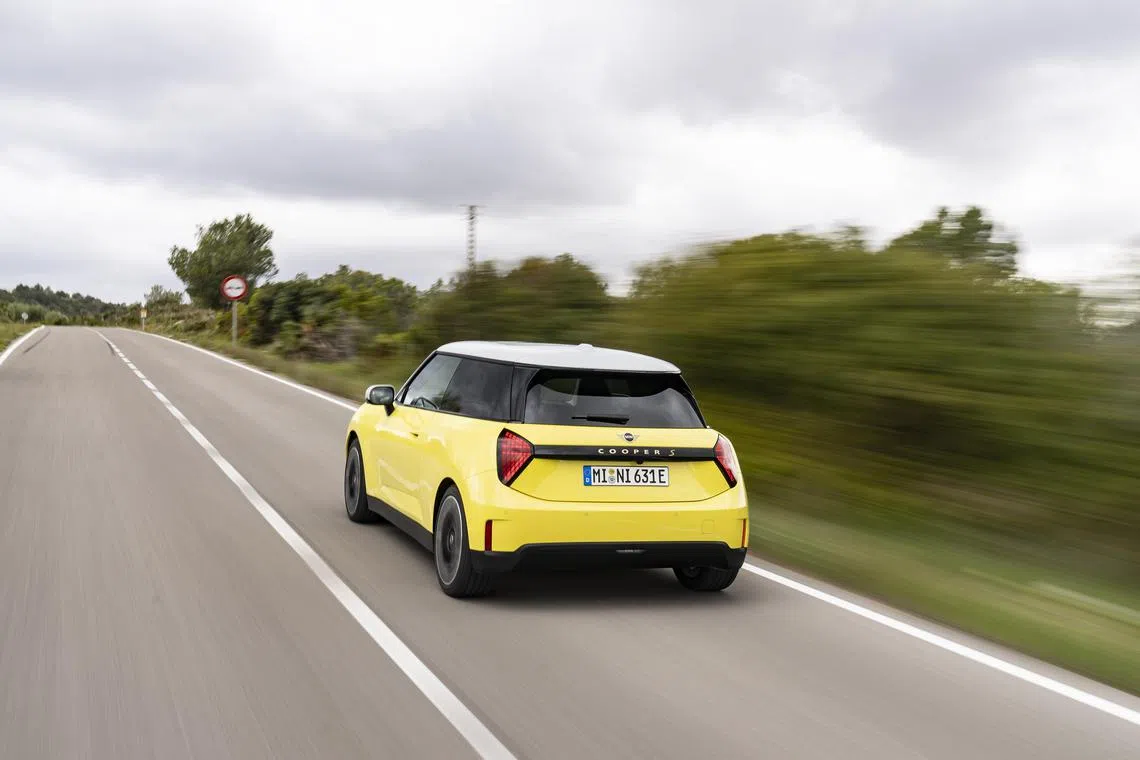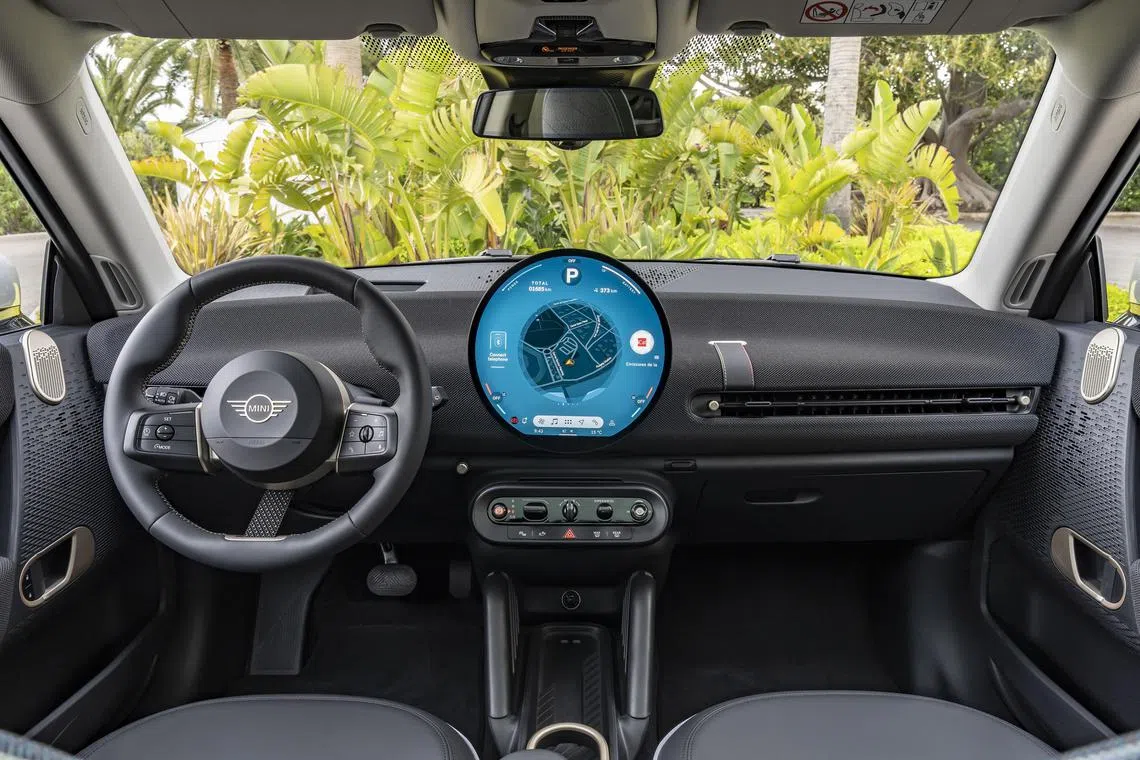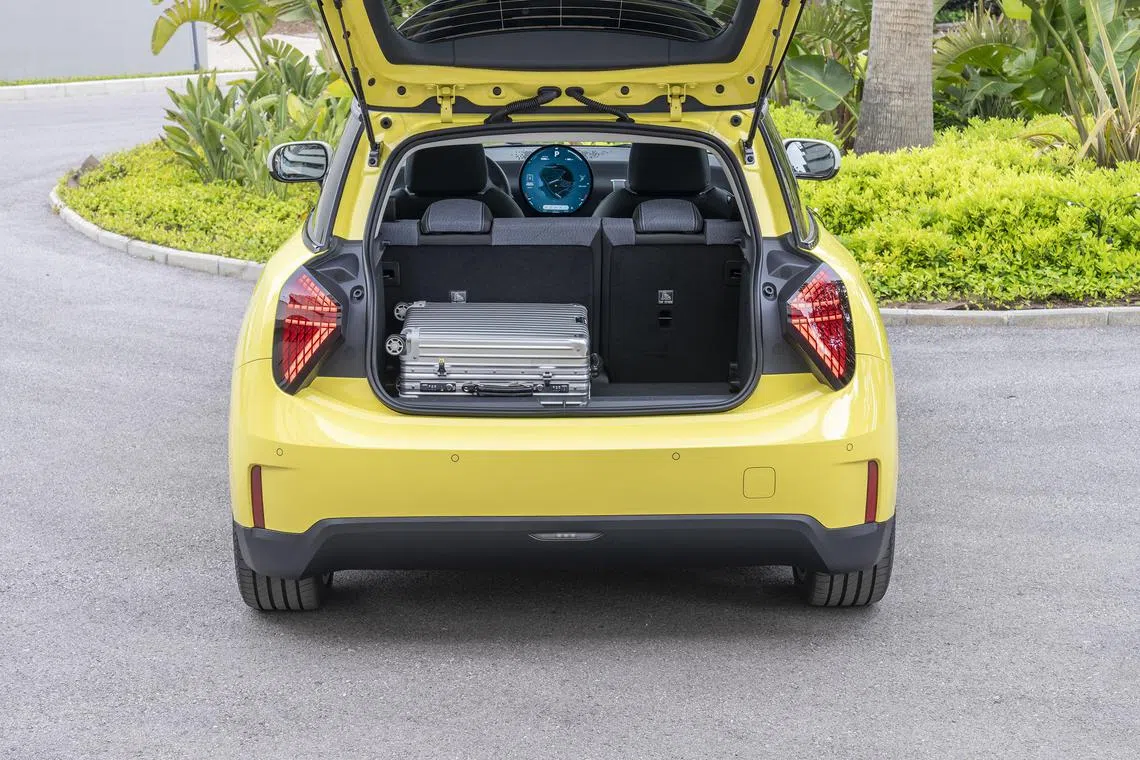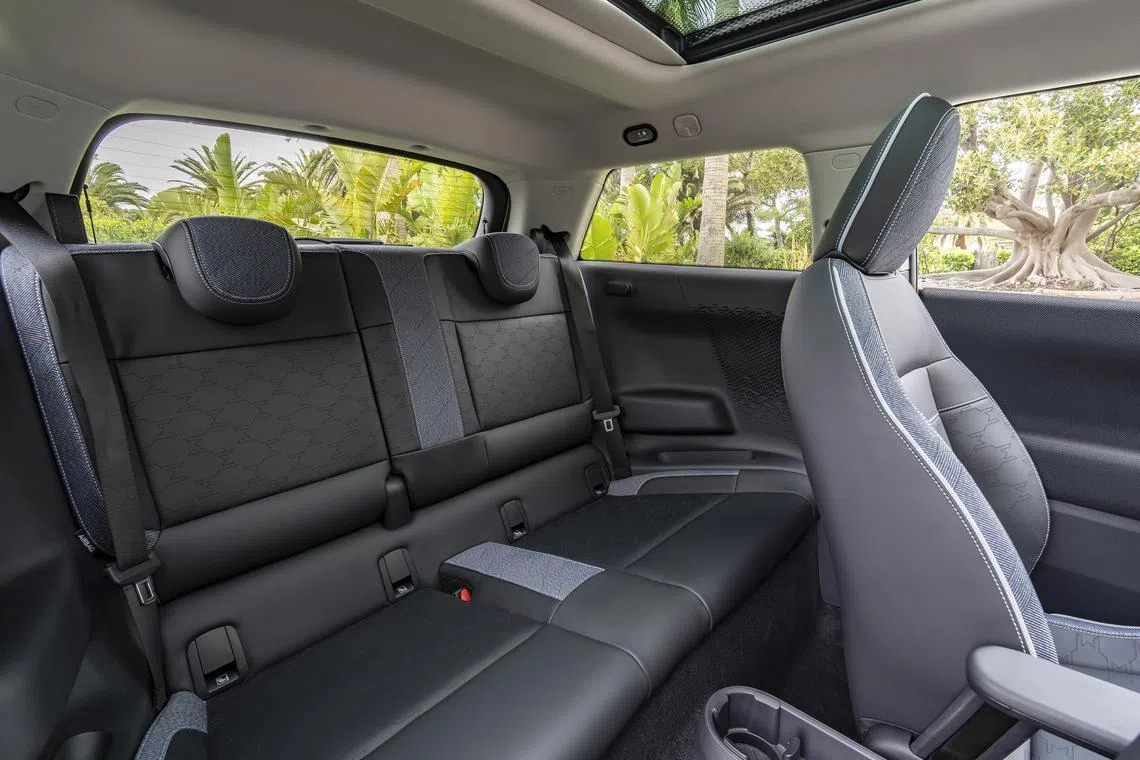Car review: New Mini Cooper EV all charged up
Sign up now: Get ST's newsletters delivered to your inbox

The electric Mini Cooper is an absolute hoot to drive.
PHOTO: BMW GROUP
Follow topic:
SITGES, Spain – The latest Mini hatchback is simply called the Mini Cooper. This simplification cannot be more timely. Its predecessor was named according to its forms (three-door, five-door), power output (One, Cooper, Cooper S, John Cooper Works) or propulsion system (Electric).
The new electric Mini Cooper rolls out from BMW’s factory in China, a joint venture with Great Wall Motor. Meanwhile, Mini’s famed factory in Oxford, Britain, will continue to make the Mini Cooper with internal combustion engines (ICEs).
Both the electric and ICE versions look identical from the outside and they are expected in Singapore.
Only the electric version of the hatchback – the Mini Cooper SE – is sampled at the international drive held in Sitges, a coastal town in Spain’s Catalonia region, some 40km south-west of Barcelona.
The Mini Cooper SE is not the brand’s first electric hatchback. BMW launched its first Mini Electric in Singapore in August 2020 amid the Covid-19 pandemic. The car impressed with its handling, but some found its ride too firm, while its limited range triggered anxiety. The launch version of the car could travel only 200km on a full charge.
The drive in Spain comes with an unusual twist. Before the actual test drive, I get to drive a real Mini in a virtual world.
How is that possible? To make it happen, the organiser prepares a carpark about the size of a football field. I get into a Mini Cooper, strap on a virtual-reality headset and my view transforms from the sandy carpark into a virtual town with colourful buildings, oversized playing cards and winding paths.
Observers would have seen me driving around the carpark, seemingly aimlessly, but I feel like Alice exploring a virtual wonderland behind the wheels of a real Mini.
Mini says the experience – which it calls “mixed reality” – is not just a novelty, but also showcases technology that can be used to test autonomous driving.
The experience is my oddest test-driving experience after reviewing cars for The Straits Times for more than a decade, but it is enjoyable in a zany way.
Coming back to reality, the Mini Cooper is familiar without being off-beat.

The rear of the new Mini Cooper looks significantly different from the previous generation with the horizontal bar connecting the triangular-themed light clusters.
PHOTO: BMW GROUP
The latest Mini has the distinctive minimalist design cues from its predecessors – short bonnet and overhang, with circular headlights and an octagonal grille.
The minimalist theme continues inside the cabin. At the cockpit, there is a two-spoke steering wheel with a stylish fabric strap as the third “spoke” and a centrally mounted round touchscreen display. Below the 9.4-inch oversized display is a panel of switches and buttons for essential functions such as ignition, parking brake, gear selection and volume control.
While there is no instrument display behind the steering wheel, a head-up display screen provides all the essential driving information such as speed and navigational turns. It even warns me of dangerous bends in advance.
The Mini Cooper’s cockpit finds a sweet spot between the extreme minimalism of Tesla’s cockpits and the massive and distracting digital display screens in some modern cars.

The high-resolution 9.4-inch circular infotainment touchscreen dominates the interior.
PHOTO: BMW GROUP
On paper, the car has a range of 402km and it can charge from 10 to 80 per cent in just under 30 minutes on a 75kW charger.
On the move, the Mini Cooper has a bewildering set of seven drive modes, or what it calls experiences – Go-Kart, Core, Green, Vivid, Timeless, Personal and Balance.
The three essential ones are Core, Green and Go-Kart. Green conserves the most battery power, while Go-Kart injects adrenaline to transform the car into a hot hatch where power delivery to the front wheels feels more instantaneous. The Core mode sits between Green and Go-Kart.
The car’s damping is fixed, so the modes mostly tweak the steering wheel’s responsiveness and throttle input.
Even in the Green mode, the Mini Cooper is enjoyable to drive.
Piloting through winding mountain roads in Catalonia, the Mini Cooper’s low centre of gravity and accurate steering feel close to a go-kart experience. Power is channelled to the front wheels, the damping leans towards being firm but not harsh, while the car feels planted at tight hairpin bends.
The steering inputs are precise, although enthusiastic drivers would have preferred a little more feedback when piloting through bendy roads.
Over a two-day test drive of about 200km, the test car averages 17.4 kWh/100km, which is slightly higher than the stated 14.1 to 14.7 kWh/100km.
The test car’s equipment level is exceptionally high – it comes with a panoramic glass sunroof, John Cooper Works sports seats, a head-up display and a Harman Kardon sound system. Some of these are expected in local cars, as buyers have come to expect them.
A cabin luggage can fit into the Mini Cooper’s boot without having to fold the rear seats down, adding to the overall practicality of the car.

The boot, which is big enough to fit a cabin-size luggage, can be further expanded with the split-folding rear bench.
PHOTO: BMW GROUP
There are three “mini” niggles.
One, while the rear legroom has improved over the previous three-door Mini, the rear seats are best reserved for children, or adults on short journeys.
There will not be a five-door version of the electric Mini hatchback, so those who plan on using the Mini as a family car will have to turn to the Aceman and Countryman – both crossovers.

The rear seats are best reserved for children, or adults on short journeys.
PHOTO: BMW GROUP
Two, the cupholders are too “mini” to be fully useful. The ones in between the front seats are somewhat shallow, while the door pocket storage is too narrow for some water bottles.
Three, Mini created 30 new sounds for driving, warning and information. Some are pleasant, like the soft ticking for turn signals, but the driving sound for acceleration takes some getting used to. My driving companion and I agree that it sounds like a spaceship.
I am not a fan of artificial sounds, so I switch it off for most of my drive after sampling it.
To be sure, these are not dealbreakers for anyone mulling over a purchase.
But what could be an obstacle may well be something more basic – its price.
The latest electric Mini Cooper is expected to arrive in July from BMW’s China factory. The ICE version is expected to arrive in Singapore from the second half of 2024.
There will be two variants available – the 160kW Mini Cooper SE tested in Spain and a less powerful 135kW Mini Cooper E version with a shorter range of 305km. Both exceed the 110kW ceiling for the certificate of entitlement (COE) Category A – this means both cars will have to be registered with the pricier Category B COE.
BMW Asia has not confirmed the prices for both cars, but it says the Mini Cooper SE will be similarly priced as its predecessor, while the Mini Cooper E will be slightly cheaper.
The outgoing Mini Electric, which was less powerful with 135kW, was last listed at nearly $259,000 with COE just before it sold out in December 2023. This means the latest Mini Cooper SE and E are likely to be among the priciest small electric cars in Singapore.
This is unless BMW produces a “Singapore Special” edition of the Mini Cooper with 110kW, to keep the car in the Category A COE.
Mini Cooper SE
Price: Estimated at $259,000 with current certificate of entitlement prices
Motor: Synchronous motor with 54.2kWh lithium-ion battery
Transmission: Single speed with fixed ratio
Power: 160kW
Torque: 330Nm
0-100kmh: 6.7 seconds
Top speed: 170kmh
Power consumption: 14.1kWh/100km - 14.7kWh/100km
Agent: Eurokars Habitat


